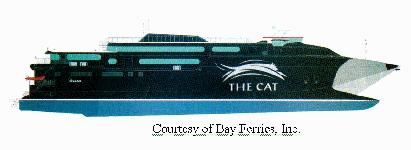
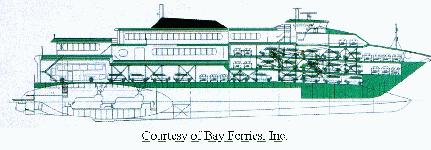
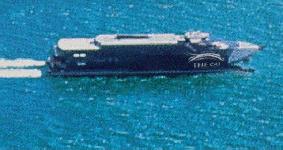
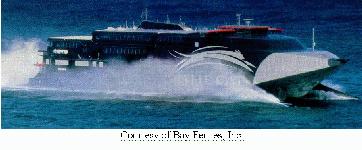
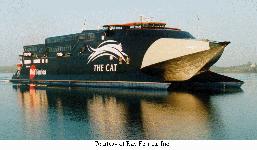
 High Speed Sealift
High Speed Sealift
High Speed Sealift (HSS)
INCAT 046 CAT Evaluation
Owen Spivey
14 July 1998
Engineers from the Military Traffic Management Command Transportation Engineering Agency (MTMCTEA) recently participated in a Center for the Commercial Deployment of Transportation Technologies (CCDoTT) evaluation of the feasibility of commercial high speed sealift (HSS) during future deployments. The evaluation was conducted in cooperation with the Military Sealift Command, the U.S. Maritime Administration, U.S. Transportation Command, U.S. Army Deputy Chief of Staff – Operations and Plans, Naval Surface Weapons Center (NSWC) Carderock, and the Logistics Management Institute (LMI). CCDoTT, acting on the behalf of and under the direction of USTRANSCOM and MARAD, was responsible for the planning, coordination, and execution of the FY98 HSS evaluation. This article is intended to provide a brief summary of our participation and the future military potential of HSS.
The U.S. Army Training and Doctrine Command (TRADOC) is conducting broad studies projecting to the year 2025 to frame issues vital to the Army’s development after 2010. Studies and war games show that the Army’s present firepower-centered approach may introduce unnecessary future risk, since a future enemy will have time to (a) become hardened to our firepower, (b) learn to lessen effects by deception, and (c) husband its military strength in preparation for the expected military assault. A recent example is Iraq’s dispersal and hoarding of Scuds during DESERT STORM. Pre-STORM estimates indicated Iraq possessed only 18 launchers; however, the estimates were later increased to 225. Even though Iraq’s Scuds were more of a political rather than a military threat, a significant percentage of F-15E sorties were diverted from infrastructure strikes to "Scud chasing". As we tighten our purse strings and shrink the force, battlefield economics will not allow the Army After Next (AAN) such diversions. Future conflicts will place greater emphasis on rapid deployment, reduced logistic requirements, precise directed lethality, joint battlefield integration, and rapid information distribution. HSS is a futuristic concept that may provide a means to meet such an end, but several things must fall into place to realize its potential.
First, the military must partner with commercial industry to leverage state-of-the-art technology, such as HSS, for military use to meet these aggressive demands. To achieve rapid strategic deployment, the Department of Defense continues to investigate several commercial HSS application vessels for possible future military deployment. For example, the Danish high speed ferry Cat-Link V set an Atlantic crossing speed record on 20 July 1998 of two days, 20 hours and nine minutes at an average speed of 40 knots, the first Atlantic crossing in under three days. HSS technology is an expanding market that is gaining visibility and popularity in the United States. Our ultimate objective is to determine whether existing and emerging HSS technologies have a viable military application that can solve future strategic mobility and logistic problems.
Just what is it that makes HSS so special? Well, the FY98 evaluation vessel (the INCAT 046 CAT) was designed and built by INCAT Inc., of Australia. It is a combined passenger/vehicle high-speed ferry originally designed for commercial freight/passenger service across the Bass Strait between Australia and Tasmania, the longest non-stop open-sea fast ferry route in the world (227 miles). With a surface piercing catamaran hull of 91 meters long and a beam of 23 meters, the CAT is capable of cruising at 43 knots (50 mph) with a rated load of 900 passengers and 240 privately owned vehicles. The ship’s transom-mounted waterjet propulsors are driven by four 9,500 horsepower diesel engines. By using vectored thrust from her propulsors, it is capable of precise maneuvering and docking without using tugboats. In addition, it demonstrated the capability of performing a "crashback" (i.e., coming to a dead stop) from 46 knots in just a third of a mile. This is amazing for a vessel of this size, especially compared to a modern aircraft carrier that requires approximately 2 miles to stop. With these credentials, the CAT was sure to warrant a closer look, especially with respect to the dynamic loads that such a vessel could impose on its cargo.
After completing a season of passenger runs in Australia, Bay Ferries of Canada Inc., purchased the CAT for commercial service between Bar Harbor, Maine, and Yarmouth, Nova Scotia. The CAT departed Hobart, Australia, on 26 April 1998 and arrived in Yarmouth on 20 May 1998. This stop provided an excellent chance for us to instrument the CAT to measure transportability data that would characterize the environment that military equipment would be required to endure. Prior to departure from Hobart, a representative from NSWC Carderock installed wave height instrumentation and engineering data recorders (EDRs) provided by MTMCTEA to measure acceleration levels at various cargo stowage locations on the vessel. Although instrumentation recovery and a military load evaluation was originally scheduled at Fort Eustis, VA, on 18 May 98, transit delays in Tahiti and the Panama Canal Zone forced cancellation of these activities. Nevertheless, the NSWC Carderock representative recovered the test instrumentation at Yarmouth for data reduction and evaluation. The data is being evaluated by Carderock and MTMCTEA to develop future HSS response models and vehicle restraint load factors for future military system design and HSS applications.
In addition to test instrumentation installation and recovery, a military vehicle loading was scheduled at Fort Eustis, home of the 7th Transportation Group, in Newport News, VA. The loading was scheduled to validate the CAT’s ability to load and transport military vehicles and to demonstrate the potential military applications to a military audience. Although the transit delay cancelled the loading, LMI and MTMCTEA felt strongly that there was valuable information to be gained from this segment. Therefore, LMI coordinated with the ship’s owners and the Maine Army National Guard (MANG) to perform a vehicle load and transit during a normal commercial operation. The MANG cooperated by providing seven military vehicles (four HMMWV ambulances, two HMMWV soft-tops, and a 5-ton truck) along with the appropriate soldier support. MTMCTEA sent three engineers/analysts to participate in the loading, combining experience in transportability engineering, operational exercises, and shipload planning. As planned, the shiploading and transit between Bar Harbor and Yarmouth was performed on 9 June 1998. The vehicles were successfully loaded and restrained during the transit, demonstrating the viability of loading light vehicles aboard this commercial ferry.
The purpose of this evaluation, the first of many planned evaluations, was to evaluate whether existing HSS technology has potential for present and future military applications. Based on our personal CAT observations and instrumentation analysis, we concluded:
1. The vessel can be used as a viable intratheater tactical marine transport.
2. Stronger decks and larger tiedown provisions would be needed to secure larger military vehicles and equipment.
3. A redesign in deck heights would be desirable as well. Available deck height on the majority of the vehicle decks was only 77-84 inches.
4. Currently there are no ISO sockets on the ship. ISO sockets and electrical outlets (for ISO containers) would be desirable.
5. The vessel would require an integral loading ramp for unimproved ports or in-stream LOTS operations.
The CAT clearly demonstrated the future potential of HSS, and it could lead to bigger and better things if expanded.
By using composite materials, new drag-reducing hull forms, digital controls, and improved engines with increased fuel efficiency, it may be possible to build a high speed strategic sealift vessel capable of transporting vehicles and materiel at speed in excess of 60 knots up to Sea State 7. If such a vessel included a troop berthing area, the reduced transit time could be used for preparation, training, and vehicle maintenance. Complete force packages could be delivered directly to the theater, reducing reception, staging, onward movement, and integration (RSOI) requirements. This would dramatically reduce the time required to transport troops and equipment from "fort to foxhole".
Furthermore, the viability of designing and building a tactical HSS vessel today is a reality. Combining existing HSS technology with passive sensors, composite materials, and reduced radar cross section (RCS), a high-speed (45 knots plus) tactical marine transport can be built to deliver small force packages within a theater of operations, i.e. a maritime equivalent of the USAF’s C-130. Such a scenario could include loading a small force package at Ad Damman, Saudi Arabia, in the afternoon, departing after dusk, and arriving in the Strait of Hormuz by dawn regardless of sea state. Both natural and man-made obstacles could be avoided using passive means such as global positioning system (GPS) navigation and downlinked data from JSTARS, unmanned aerial vehicles, and space-based reconnaissance. In keeping with the AAN philosophy, all of these options present viable considerations.
Clearly, the INCAT CAT evaluation is a good example of "thinking outside the box" to explore potential AAN applications. A joint working group representing potential future military sealift users was able to partner with industry to evaluate emerging commercial technology with an eye to future military applications; in fact, MTMCTEA was able to forge several key relationships. For example, MTMCTEA and LMI worked together to establish the viability of loading military vehicles aboard the CAT; MTMCTEA and NSWC Carderock coordinated vessel test instrumentation and data collection to characterize the dynamics of the transportation environment; and MTMCTEA, LMI, and the MANG jointly validated the capability to load and transport military vehicles aboard the CAT. MTMCTEA continues to work in concert with LMI, TRANSCOM, NSWC Carderock, MARAD, and other interested parties to establish transportability engineering criteria for emerging HSS vessel designs as well as providing HSS analysis results to future AAN analyses and simulations. As always, MTMCTEA’s goal is to optimize force projection by turning today’s visions into tomorrow’s reality.





This article reflects the thoughts and opinions of the author and does not represent the official position of MTMCTEA. We wish to acknowledge Mr. John Newman (MTMCTEA), Mr. Matt Difiore (LMI), Mr. Martin Dipper (NSWC Carderock), and the Maine Army National Guard for their exceptional support toward the successful completion of this evaluation, and Mr. John T.H. Germanos for his guidance on this article.
Author’s biography
Mr. Owen Spivey is a 1981 engineering graduate of North Carolina State University. He worked at Newport News Shipbuilding for eleven years where he was responsible for testing submarine and aircraft carrier reactor plants. He came to MTMCTEA in 1992 where he has applied his practical shipbuilding and operation knowledge to the challenge of global military deployment and transportation. His e-mail address is: [email protected].